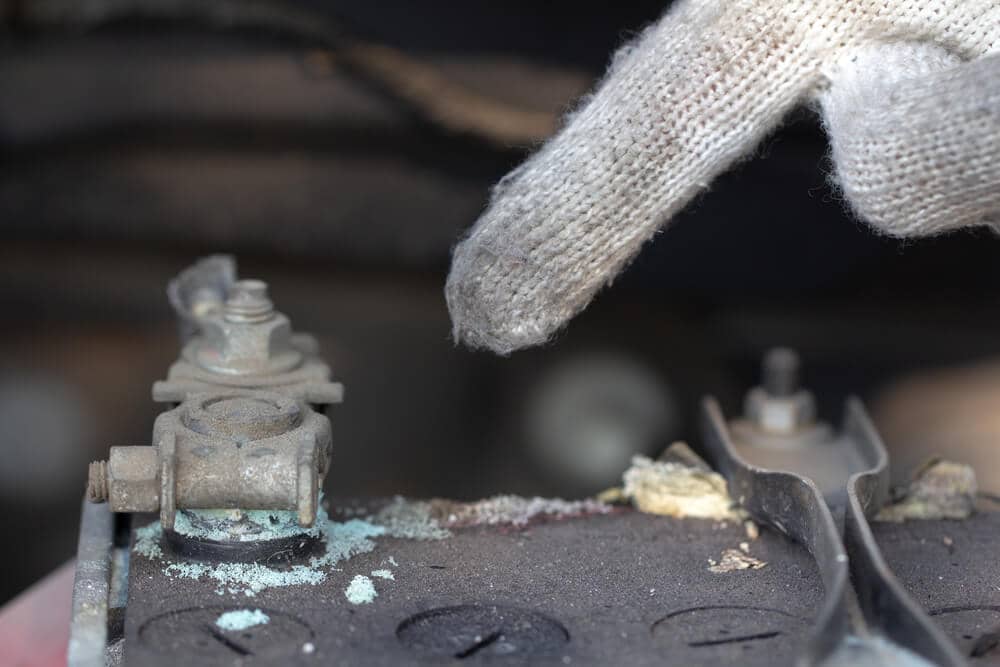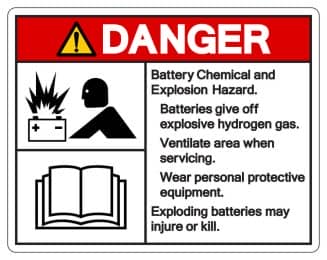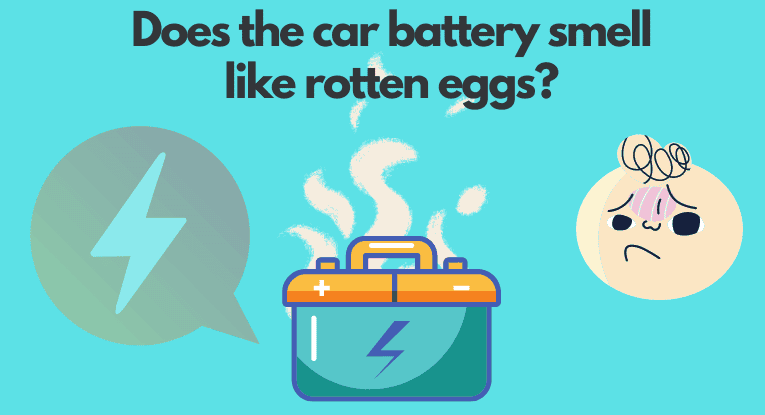You get inside the car and notice the stinky smell of rotten eggs, but you’re sure you didn’t leave any eggs inside the vehicle, or nobody has thrown rotten eggs at your car. Believe it or not, the annoying odor comes from the car battery.
Of course, another reason might be a broken catalytic converter which you can detect by the smell of the exhaust fumes that permeate the surrounding air, but that’s another topic.
What Causes a Car Battery to Smell Like Rotten Eggs?
Your internal combustion car probably has a lead-acid battery which can produce a lot of power for starting the engine. These batteries run by exchanging electrons in a chemical reaction between lead plates, lead-oxide plates, and sulfuric acid; hence, they are called lead-acid batteries.

Besides the rotten egg smell, this chemical reaction also called “sulfation” reduces the battery’s life expectancy and capacity. Thus, it needs to be addressed as soon as it’s noticed!
Understanding Sulfation in Car Batteries
Sulfation in car batteries occurs when lead sulfate crystals accumulate on the battery plates. This typically happens when the battery is undercharged, deeply discharged, or aging. During normal operation, the lead and lead dioxide plates react with sulfuric acid during the charge and discharge cycles.

However, when a battery is not fully recharged, lead sulfate crystals can form and harden on the plates, reducing the battery’s ability to accept, hold, and deliver power. This process is often accelerated in batteries that are frequently only partially charged or left in a discharged state for extended periods.
Recognizing and understanding sulfation is crucial as it is one of the primary causes of reduced battery capacity and lifespan.
Is it Safe to Drive a Car That Has the Rotten Egg Smell?

Once the batteries start smelling like rotten eggs, they are sulfated so much that they can’t recharge properly, especially if you pop up the hood and find lead sulfate on the battery heads. These are symptoms of a dying battery. Therefore, once you detect the foul egg odor, you have to change the battery.
Suppose you continue to use the broken battery, although the alternator will deliver power to the battery from the car’s motion. In that case, the battery capacity is too low to provide enough energy to start up your vehicle. Thus, you might get stranded in the middle of nowhere due to a battery malfunction.
What Happens if You Smell a Sulfated Battery?
 Your body has an automatic alarm that keeps you away from hazards. Therefore, if your food has gone bad, you can avoid intoxication by simply avoiding the stinky food. The same applies to car batteries. In fact, the smell comes from H2S, a byproduct of sulfate, which is fatally toxic, even in relatively low concentrations.
Your body has an automatic alarm that keeps you away from hazards. Therefore, if your food has gone bad, you can avoid intoxication by simply avoiding the stinky food. The same applies to car batteries. In fact, the smell comes from H2S, a byproduct of sulfate, which is fatally toxic, even in relatively low concentrations.
Don’t worry, though; the rotten egg smell is only detectable at concentrations lower than 20 ppm. At this level of exposure, prolonged exposure might cause headaches, nausea, tearing of the eyes, and of course, the irritating smell.
H2S can become odorless at higher concentrations, so don’t try to smell the battery at all, as you will breathe in more of the toxic gas. Exposure to higher concentrations of the gas can cause nose, throat, and lung irritations.
In addition, you can tell the battery has a problem by checking the indicator or observing sulfate on the battery heads. Sulfate is a crumbly white material that will stick to the battery heads, where it’s supposed to be a clean metal surface.
How do You Get Rid of the Rotten Egg Odor?
We will cover how you can revive the sulfated battery, yet the repaired module will not fully recover to the initial capacity. We strongly recommend that you don’t try to fix the battery by yourself. If your car is under warranty, you contact the manufacturer to change your battery.
However, if you drive a car with a mileage beyond warranty and want the battery fixed with minimal cost, you can revive the sulfated battery. The desulfation process might take up to two or three weeks. It requires some equipment, and it will never fully recover the battery.
Furthermore, car batteries cost from $50 to $150, which might not be worth the time and effort. Therefore, we suggest buying a new battery; however, if you insist, follow the steps below:
Recover your car battery safely
Caution! This process involves overcharging the dead battery, possibly overheating, hydrogen ignition, and acid wounds. Check for safety instructions at every step of the process.
Required tools
First, check the following equipment:
An old battery charger with no smart microcontroller:
- The charger won’t do the trick if the controller is smart because you actually have to overcharge the battery during this process.
- A current meter
- A voltage meter
- An ordinary charger suitable for the car battery
- A 2Ohm resistor
- A 400W DC lamp or 400W AC with a power inverter.
- Battery electrolyte
- Two wires with alligator clamps at both ends
How to desulfate the battery:
- Remove the battery from the car.
- Connect the positive batter head to a resistor using the alligator clamp, connect the resistor to the current meter, and then the positive end of the charger.
- Connect the negative head to the negative end of the charger.
- Turn on the charger. At this stage, the current meter must show a number close to zero. Sometimes, the current meter shows absolute zero, but don’t worry, the numbers should increase slowly and steadily as some hours pass.
- Once the current is stable at 10Amp or 20Amp, let the battery charge for 48 hours.
- After two days, disconnect the battery from the charger safely. Check the battery voltage using the voltmeter. If the voltage exceeds 12V, continue to the next step; if not, recharge for another 48 hours. If the battery still doesn’t get to 12V, it is time to dispose of it.
- Store the battery for 24 hours and check the voltage. If the voltage has dropped under 11V, dispose of the battery and get a new one. If not, proceed.
- Now, you have to cycle the battery a few times to recover the battery cells effectively. You can discharge the battery using the lamps or the car’s headlights. When the battery voltage reaches 11V, disconnect the battery.
- Recharge the battery using the ordinary charger until it reaches 12.5V.
- Discharge it again. Every time you charge and discharge the broken battery, it should light the lamps for a more extended period. Repeat cycling the battery until cycling no longer improves battery durability significantly.
- Now your battery is good to go.
A word of caution!
Please note that this is a potentially dangerous process due to the risks of overheating, acid spills, or even an explosion from igniting hydrogen gas. It’s essential that you approach such a method with extreme caution, if at all. Furthermore, not all batteries will respond to desulfation, and many professionals consider heavily sulfated batteries to be beyond repair.
Symptoms of a Failing Battery
It’s a scenario many dread: turning the ignition key only to be greeted with silence or a weak attempt by the engine to turn over. While the infamous rotten egg smell is a telltale sign of battery troubles, there are other indicators you shouldn’t ignore. Dimming headlights, frequent jump starts, or a slow engine crank can all be harbingers of a battery on its last legs.
Regularly assessing your car battery’s health can prevent unexpected failures. Tools like multimeters and battery testers are essential for this.
A multimeter can measure the voltage across the battery terminals to indicate its state of charge. A reading of 12.6 volts or higher typically indicates a fully charged battery, while anything below 12.2 volts suggests a discharged battery.
Battery testers can provide more detailed information, including the battery’s ability to hold charge and its overall health. Regular testing can help you identify issues like sulfation early on, allowing for timely intervention and maintenance.
Recognizing Signs of a Failing Alternator
The alternator is crucial for charging your car battery and powering the electrical system while the engine is running. Signs of a failing alternator include dimming headlights, electrical malfunctions, or the battery warning light on your dashboard.
A malfunctioning alternator can lead to insufficient charging of the battery, hastening its degradation and potentially leading to issues like sulfation. If you notice these symptoms, it’s important to have your alternator checked as soon as possible. Addressing alternator problems promptly can prevent further damage to your battery and ensure your vehicle’s electrical system functions correctly.
Car Battery Maintenance Tips
A battery, like any other vital component of your car, requires regular maintenance to ensure optimal performance. Preserving the health of your battery doesn’t just extend its life—it also ensures that you’re not left stranded on a cold morning. Simple practices, like making sure your vehicle is regularly driven, storing it away from direct sunlight during extreme temperatures, and using a trickle charger during long periods of inactivity, can make a significant difference.
Another important thing to keep in mind is to not leave your headlights on while the engine is off, since they will rapidly deplete the battery. Some modern cars have warning systems that help you quickly notice if you left the headlights on. However, in most cars, it’s only up to you to be mindful and make sure they’re turned off before you leave the car.
Environmental Impact on Battery Health
Environmental factors, particularly temperature extremes, play a significant role in your car battery’s health and performance. High temperatures can increase the rate of chemical reactions inside the battery, leading to faster degradation of both the battery plates and the electrolyte.
This can result in increased water loss in the battery, and potentially, a higher likelihood of sulfation. On the other hand, cold temperatures can reduce the battery’s effective capacity, making it harder for the battery to deliver the necessary power, especially during engine start-up.
To protect your battery, try to park your vehicle in a garage or shaded area during extreme temperatures and regularly check your battery’s condition.
Alternative Battery Types
As automotive and electronic needs have evolved, so have our energy storage solutions. While traditional lead-acid batteries continue to dominate car starting systems, alternative batteries such as Lithium-ion, AGM (Absorbent Glass Mat), and Gel batteries are emerging in the fray. These alternatives often offer longer lifespans, reduced maintenance, and better resistance to issues like sulfation. However, their costs and specific applications can vary.
Additional Safety Precautions
Venturing under the hood of your car can be as exhilarating as it is daunting, especially when dealing with components as volatile as batteries. From the corrosive acid within them to the risk of explosive gases they emit, it’s crucial to approach with caution. Simple precautions, like ensuring you’re in a well-ventilated space, wearing protective gear, and avoiding open flames, can be the difference between a quick check and a trip to the emergency room.
Conclusion
If your car battery stinks like a rotten egg, it is time to change the battery. The unpleasant odor is toxic at high concentrations, so avoid sticking your head under the hood and smelling the batteries. Instead, contact the manufacturer to change the battery for you. Alternatively, you can save a few bucks by desulfation the battery. However, the electrochemical process is hazardous, time-consuming, and might revoke the car’s warranty. At the end of the day, it won’t fully recover the battery.
